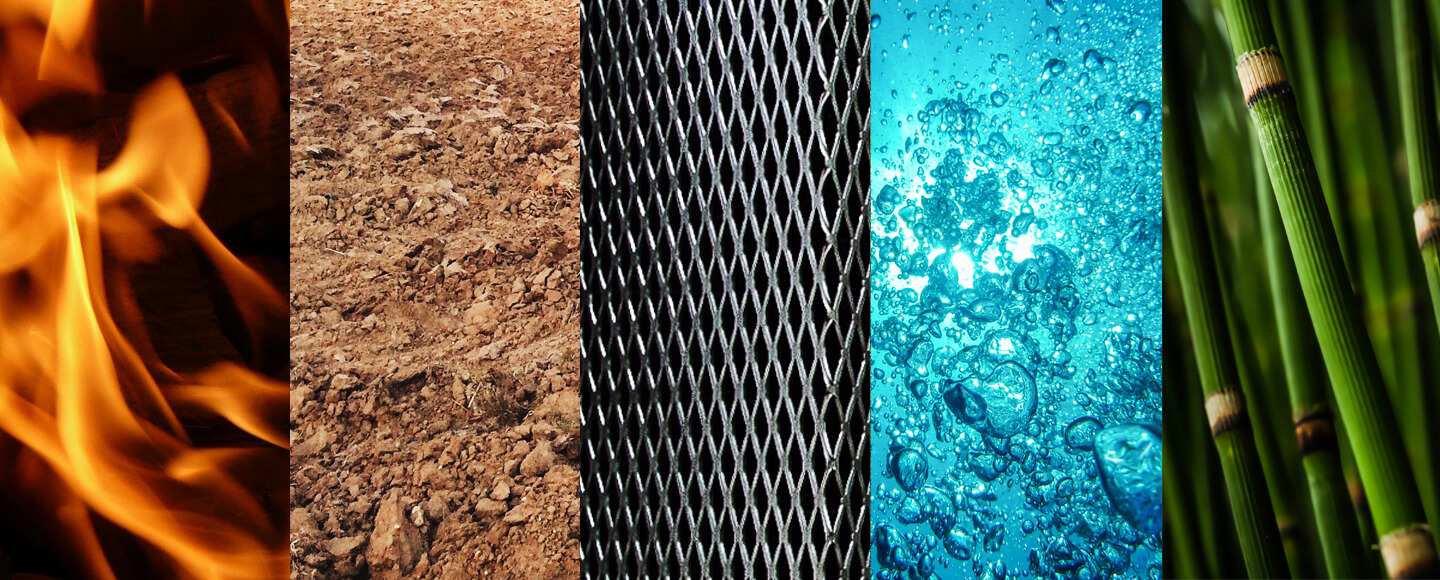Summary of the 5 elements and their significance in feng shui
Feng shui, the art of energising and harmonious living, is based on 5 elements: fire, earth, metal, water and wood. This Taoist philosophy is concerned with identifying the connections and interactions between these 5 elements, the phases and individual phenomena that make up life and also with the understanding of their meaning. These interactions can be sensed throughout nature and by humans. If the forces are balanced, an individual will be in harmony with their environment, and therefore healthy. However, if the 5 elements are not balanced, diseases and weaknesses can develop. Each element manifests itself in particular organs and emotions, as well as in intellectual and physical functions.
Fire
Fire is associated with the south, and therefore with summer and heat. It is connected with themes such as self-confidence, fame, image, recognition and inner light. Fire is also associated with young women between the ages of 15 and 30, and the second daughter in a family. Emotions such as warm-heartedness, joy, the capacity for love, and contagious enthusiasm belong to the element of fire.
This element’s colours include all bright red and orange tones, and shades of pink, apricot and violet with a significant red component.
The related organs are the heart, small intestine, eyes and circulatory system.
Earth
Earth is associated with the south-west and north-east compass points, and with the centre (tai chi). Related concepts located in the south-west include partnership, teamwork, mothers, wise women, queens, women in general and Indian summers. In the north-east, we find ideas about knowledge, spirituality and introspection. The more detailed analysis is dedicated to the third or only son or boys under 15 years old. Health and the immune system are the key themes of tai chi. Earth is associated with emotions such as care, consideration, receptiveness, nurture, cultivation and mothering.
Its colours include all shades of yellow, brown, ochre, beige, sand and concrete.
The related organs: stomach, spleen, skin, upper back, shoulders, neck, arms, hands, male sex organs.
Metal
Metal is located in the west in autumn and the north-west in late autumn. In the west, metal is associated with the following themes: children, creativity, realising projects, and a zest for life. It is linked to girls under 15 years old and to the third or only daughter. The concepts associated with the north-west are clients, mentors, helpful friends, family members such as fathers, men over 45 years old, bosses and kings. Related positive emotions include living according to the pleasure principle, being connected, harvesting, structure, the ability to concentrate, and a love of order.
The colours of metal are white, silver, gold, shiny grey, and violet with a significant blue component.
The related organs: the large intestine, mouth, teeth, chest, hips, lungs, head, brain, spine, bones and central nervous system.
Water
Water is associated with the north and winter. This element is connected with concepts such as life flow, success, careers and vocations. Metal is particularly relevant to the second son and young men between the ages of 15 and 30, and their concerns. Related positive emotions include trust, a sense of flow, strong creativity, musicality and communication skills.
Appropriate colours include all shades of blue, black, anthracite, turquoise, polar blue and blue-violet.
The related organs are the kidneys, bladder, ears and sex organs.
Wood
Wood is associated with the beginning of spring in the east and spring in the south-east. Relevant themes in the east include families of origin, company hierarchies, teachers, superiors and the first son or men between the ages of 30 and 45. In the south-east, the themes are happiness, money and prosperity, and the first daughter or women between the ages of 30 and 45. Related emotions include joy, desire, activity, development and sowing seeds.
Wood colours include all shades of green, from yellow-green with a significant yellow component to dark blue-green and turquoise with a significant green component.
The related organs are the liver, gall bladder, respiratory system and sense of smell.

